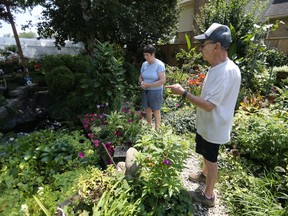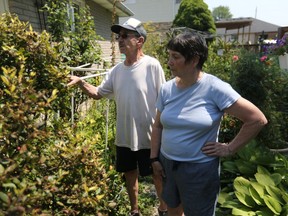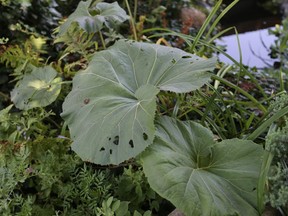Infested — Invasive Japanese beetles eating their way through eastern Canada and more

Article content
Parts of eastern Canada and much more are under siege from the invasive Japanese beetle, which appears to be spiking in population while tearing through thousands of plants and trees across the region.
Since early spring, Windsor-area master gardener Barb Morden has waged a daily battle against the Japanese scarab beetle in her Tecumseh garden.
Recommended Videos
“We go out two or three times a day and kill them,” Morden told the Star.
“They’re eating everything. They’re really, really bad.”
The pest isn’t new to Windsor, but it appears to be thriving here more than usual.
The larvae prefer turf grass and are a “major pest” in parks and golf courses, according to the Canadian Food Inspection Agency (CFIA).
The adult beetles attack the roots, foliage, and fruit of roughly 300 different kinds of plants. Its wide range of victims include elm, maple, rose, zinnia, corn, asparagus, grape, apple, blueberries, raspberries, and blackberries.
They skeletonize foliage, devouring the leaf tissue and leaving behind only the veins.
“You can tell by the holes in the plants,” said Morden. “They eat the leaves. They make holes in the leaves. They hit your vegetables as well as your fruit.”
The hungry bugs are officially known as Popillia japonica, and measure about 15 mm long by 10 mm wide. Males are usually smaller than females. They feature iridescent copper-coloured elytra (wing casings) and a green thorax and head. A row of white hairs project from under the wing covers.
The insect spends most if its life as a larva in soil, emerging in the spring when temperatures rise, and only 30 to 45 days as an adult.
The beetle is native to the main islands of Japan, where it is not considered a pest, thanks to natural predators there. In North America, however, it’s a different story.
English entomologist Edward Newman wrote about the Japanese beetle in 1841. The Canadian food inspection agency said the invasive insect was first detected on North American soil, at a New Jersey nursery, in 1916.
The first recorded Canadian appearance was in 1939. A Japanese beetle was discovered in a tourist’s car arriving in Yarmouth, N.S., from Maine. The same year, three more beetles were captured in Yarmouth and four more were found in southern Quebec.
The beetle is now considered “established” in Ontario, Quebec, Prince Edward Island, New Brunswick, Nova Scotia, and many U.S. states, according to the CFIA. The Japanese beetle has also been detected across Canada, including in 2017 in the Vancouver area.
“We have seen an increase in reports of Japanese beetle from regulated areas across Canada, however, it is important to note that Japanese beetle is considered ‘established’ in the province of Ontario,” the CFIA said.
Because the beetle is already established in Ontario, the CFIA said it does not conduct annual monitoring for the pest and does not have population data for Windsor or elsewhere.
But Morden said the numbers in Windsor area have obviously increased. She kills at least 15 to 20 a day.
“I would say they probably doubled in population,” said Morden, who attributes the proliferation to increasingly hot weather.
She said the beetles usually start appearing in early spring.
“Right now, I’d say they’re at their peak mating season,” she said.
“It’s better to kill them now, because what they do is they lay eggs in your grass, and then you have a problem with insects in your grass.”
Morden said one of the best ways to kill the pest is neem oil, which has been used as a natural pesticide for hundreds of years and is safe for people and pets. She adds some dish soap to it.
If you can’t find neem oil, Morden suggested mixing one teaspoon of dishwasher liquid, one cup of vegetable oil, one cup of rubbing alcohol and four cups of water in a spray bottle.
“You spray them,” she said. “These beetles have two holes at the top of their neck, and what you’re doing is they’re clogging their air holes.”


The CFIA said recommending ways to deal with an infestation is outside of its mandate.
But the agency does try to prevent the spread to pest-free areas by regulating the movement of items that can carry Japanese beetles, such as plants with soil or “soil-related matter.”
“The provinces of Ontario, Quebec, Nova Scotia, New Brunswick and Prince Edward Island are considered infested with Japanese beetle and movement of regulated articles from these areas to other parts of Canada must meet certain requirements to prevent further spread,” the CFIA said.
The food inspection agency added that citizens can do their part to prevent the invasion into other parts of Canada.
“The CFIA is asking for everybody’s assistance in avoiding the movement of regulated articles out of the regulated areas without prior written permission from the CFIA,” the agency said.
“You can also assist the CFIA by reporting all illegal movement of regulated articles, and by reporting all sightings of Japanese beetle outside of a regulated area.”














Postmedia is committed to maintaining a lively but civil forum for discussion. Please keep comments relevant and respectful. Comments may take up to an hour to appear on the site. You will receive an email if there is a reply to your comment, an update to a thread you follow or if a user you follow comments. Visit our Community Guidelines for more information.